Gujarat Board GSEB Solutions Class 7 Social Science Chapter 5 Location and Time Textbook Exercise Important Questions and Answers, Notes Pdf.
Gujarat Board Textbook Solutions Class 7 Social Science Chapter 5 Location and Time
GSEB Class 7 Social Science Location and Time Textbook Questions and Answers
Answer the following questions in brief
Question 1.
How much time does one longitude take to pass from the sun?
Answer:
4 minutes
Question 2.
Draw a circle and mark important latitudes on it.
Answer:
The figure of the globe of the earth with important latitudes drawn on it is below:
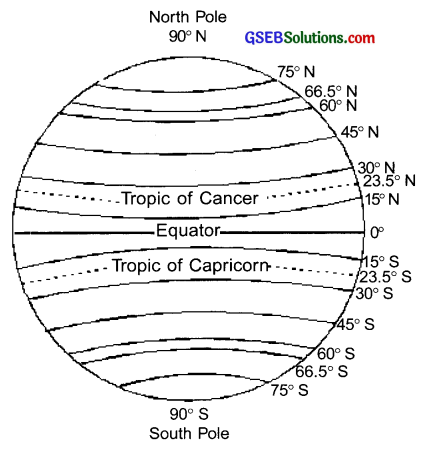
![]()
Question 3.
Draw a circle and mark important longitudes on it.
Answer:
The figure of the globe of the earth with important longitudes drawn on it is below:

Question 4.
Which circle is 0° latitude? How is it? Where are the countries of USA, Brazil, Russia, Norway and England located from 0°?
Answer:
The Equator; It is circular in shape, spreads from east to west and is the biggest latitude.
USA, Russia, Norway and England lie in north of 0° whereas Brazil lies to the south of 0°
Question 5.
With the help of mobile phone, find out some cities ahead and behind Greenwich Line.
Answer:
Ahead – Sydney, Hong Kong, Delhi, Tokyo; Behind – New York, Washington, Toronto, Los Angeles.
Question 6.
Which circle is 0° latitude?
Answer:
The Equator; It is circular in shape, spreads from east to west and is the biggest latitude.
GSEB Class 7 Social Science Location and Time Additional Important Questions and Answers
Question 1.
What are latitudes and longitudes? Explain.
Answer:
- The earth is divided into various parts through some lines.
- However these are not drawn on the earth.
- They are imaginary lines which help us study the earth and its geography better.
- Such horizontal lines drawn on the globe are called latitudes.
- While the vertical lines on the globe are called longitudes.
![]()
Question 2.
What are hemispheres? Explain.
Answer:
- The 0° latitude called the Equator passes horizontally from the centre of the earth, right from the west direction to east.
- Thus, the Equator divides the earth into two halves. These halves are known as hemisphere.
- The part of the earth above the 0° latitude (Equator) in the north is called Northern Hemisphere while the part of the earth below the Equator in the south is called Southern Hemisphere.
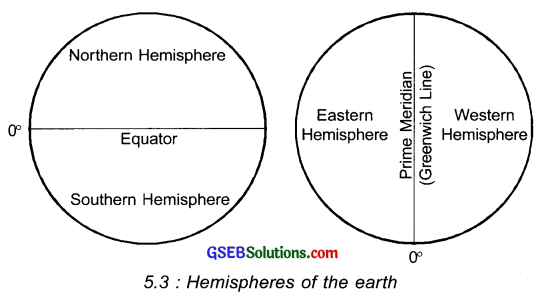
Question 3.
Where are the below mentioned countries located from 0° latitude?
Answer:
USA, Brazil, Russia, Norway, England, Kenya, Mongolia, Chile, South Africa, Egypt, Canada.

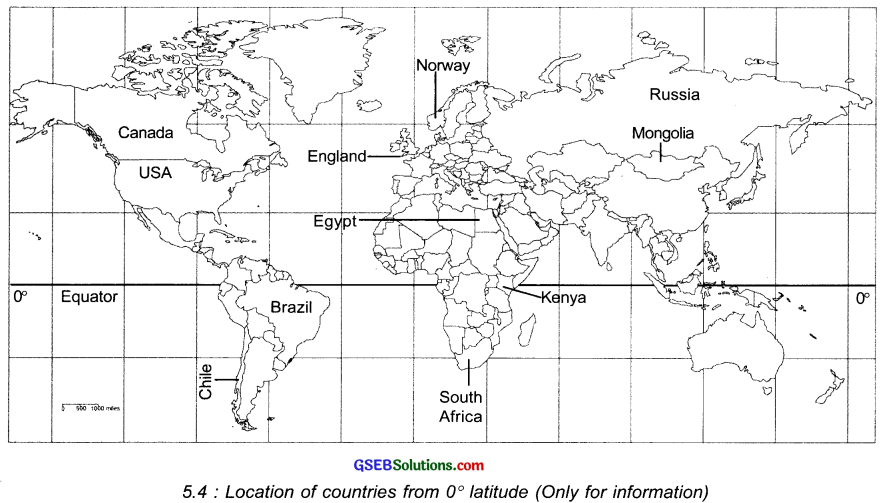
Question 4.
Answer the following questions:
Answer:
(i) Through which countries does the Equator pass?
(ii) Through which countries does the Tropic of Cancer pass?
(iii) Through which countries does the Tropic of Capricorn pass?
Countries on Tropic of Cancer, Equator and Tropic of Capricorn
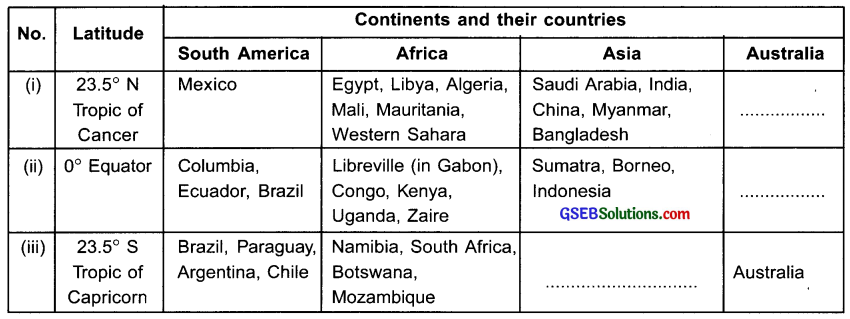
Note: 1. For location of these countries, refer map number 5.4.
2. Whole Sumatra lies in Indonesia where as only a part of Borneo belongs to Indonesia.
![]()
Question 5.
Write a note on longitudes.
Answer:
- The vertical imaginary lines drawn on the globe of the earth are called longitudes.
- The longitudes are drawn from the north to the south direction.
- There are 180 longitudes in the east of the 0° longitude.
- Similarly there are 180 longitudes in the west of the 0° longitude.
- Thus in total there are 360 longitudes.
- The 0° longitude passes through England, France, Spain, Algeria, Mali, Porto, etc.
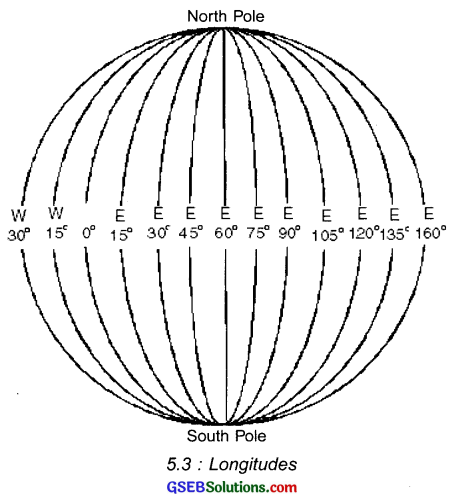

Question 6.
Write a short note on Greenwich Line.
Answer:
- The 0° longitude which divides the earth into two halves, namely Eastern and Western Hemispheres is called Greenwich Line or Greenwich Meridian.
- Since it passes through Greenwich of England, it is called so.
- There are 180 longitudes on both sides of the Greenwich Line.
- The Greenwich Line is drawn from the north to the south.
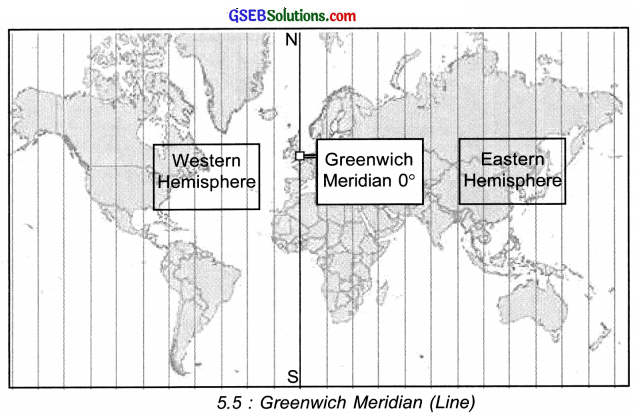
Question 7.
Make a list of the nations that fall in the Eastern Hemisphere and those In the Western
Hemisphere.
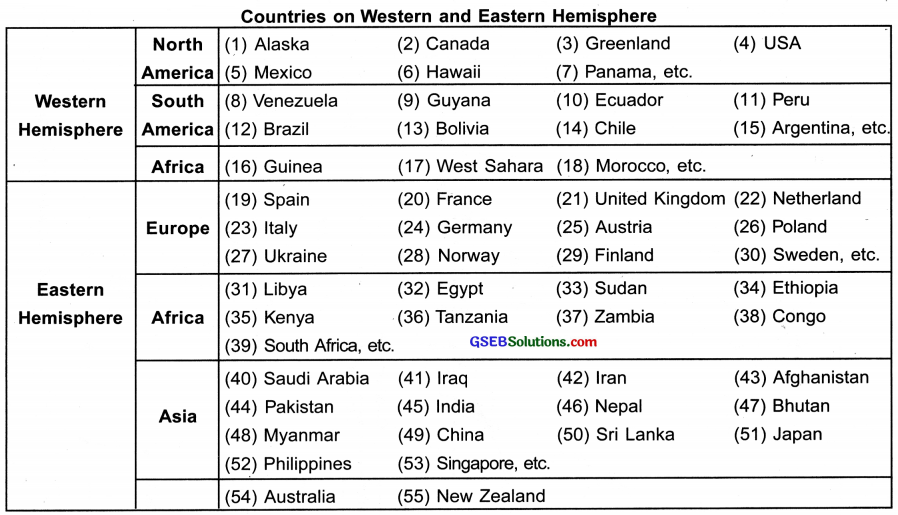
Note: For location of these countries, refer map number 5.6.
![]()
Question 8.
Write a note on International Date Line (IDL).
Answer:
- The International Date Line is an imaginary line on earth from North to the South pole.
- IDL is the International Date Line.
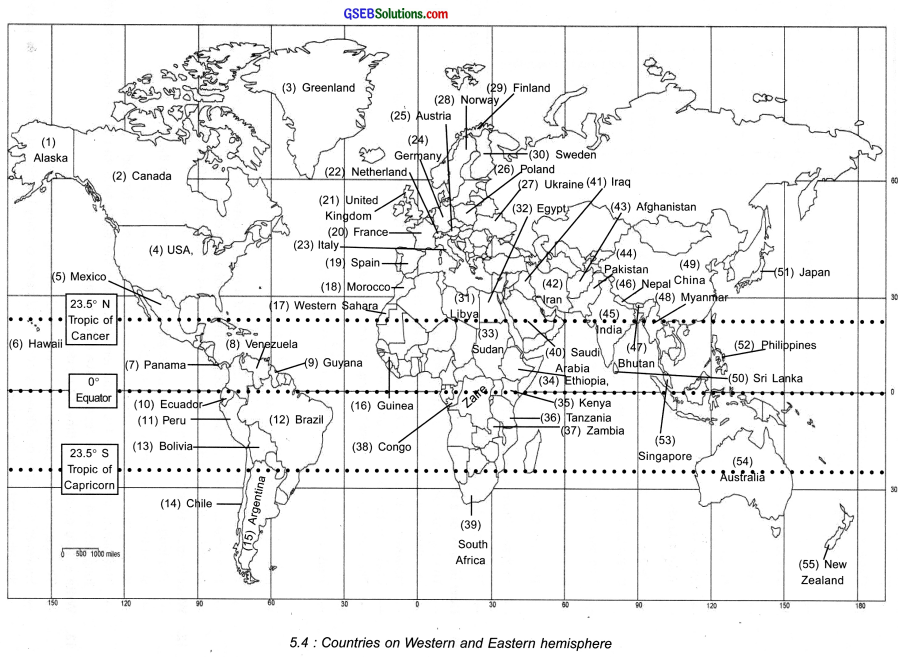
- The 180° longitude is known as International Date Line.
- There is only one longitude at 180°.
- It passes through the Pacific Ocean.
- When a person crosses IDL, the date and day change.
A. Shape of the IDL:
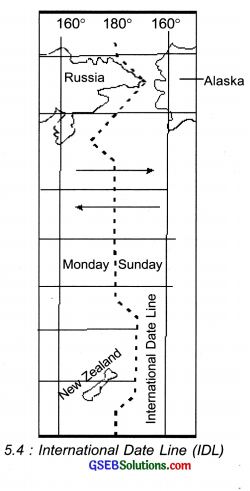
- The IDL is supposed to be straight but it is not.
- At quite a few places, it is zigzag.
- When drawn straight, this longitude passes through many islands of the Pacific Ocean.
- Hence, when the line passed through such islands, the locations there had two days and dates.
- This created a disorder for these islands.
- Hence the IDL was drawn only from the water bodies.
- Thus the IDL does not pass from any land forms.
- To draw it from water bodies, it had to be made zigzag.
- Thus, the shape of the IDL is zigzag.
Question 9.
How is time of a location decided?
Answer:
- The biggest clock of the earth is the sun.
- The time of a place is decided by the location of the sun in the sky.
- However, to be precise, the time of the places on the earth is decided through longitudes.
- There are total 360 longitudes on the earth.
- The earth takes 24 hours to complete one rotation.
- Thus, in one hour, 15 longitudes (\(\frac{360}{24}\) = 15) pass through the sun.
- In other way, it takes 4 minutes (\(\frac{60}{15}\) = 4) for the earth to pass one longitude through the sun.
- This makes it clear that there is difference of 4 minutes between two adjacent longitudes.
- This time difference is used to decide the time of a particular place.
- According to this, the time at different longitudes is different at different places on the earth.
Question 10.
What is local time?
Answer:
- The longitude which faces the sun exactly from front helps decide the local time.
- When the sun is exactly on this longitude, it is 12 pm or 12 noon.
- Keeping this time as the base, the local time of the place is decided.
- The places located on the same longitude have the same time and places located at different longitudes in the same country have different time.
![]()
Question 11.
Write a note on standard time.
Answer:
- There are many longitudes in a country, each showing a different time.
- However, if the time of different places in the same country is different, then it creates problem in the administration of the nation.
- Therefore, we have a standard time in our nation.
- Standard time means a fix time which is common for the entire nation.
- It is fixed on the basis of any one longitude of the country.
- It is fixed by following the local time of any one place which is situated in the middle of the country.
- The Standard time of our country has been fixed from the 82.5° E longitude which is located near Allahabad.
- That means if it 8:00 am in Allahabad, it is so all over India.
- Standard time allows people to be punctual in their work.
- Large countries like Australia which are extended towards east and west have more than one standard time.
Question 12.
Why is the IDL zigzag? OR Give reason: The International Date Line is not straight.
Answer:
A. Shape of the IDL:
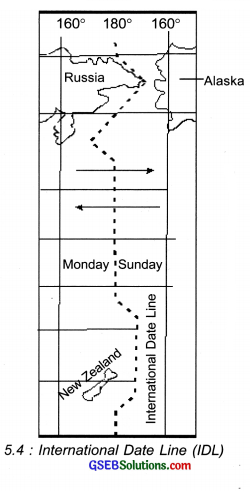
- The IDL is supposed to be straight but it is not.
- At quite a few places, it is zigzag.
- When drawn straight, this longitude passes through many islands of the Pacific Ocean.
- Hence, when the line passed through such islands, the locations there had two days and dates.
- This created a disorder for these islands.
- Hence the IDL was drawn only from the water bodies.
- Thus the IDL does not pass from any land forms.
- To draw it from water bodies, it had to be made zigzag.
- Thus, the shape of the IDL is zigzag.
Question 13.
Write a short note on the main longitudes of the earth.
Answer:
- There are two main longitudes of the earth. They are:
A. Greenwich Line, B. International Date Line.
- The detailed explanation of these is as follows:
A. Greenwich Line:
- The 0° longitude which divides the earth into two halves, namely Eastern and Western Hemispheres is called Greenwich Line or Greenwich Meridian.
- Since it passes through Greenwich of England, it is called so.
- There are 180 longitudes on both sides of the Greenwich Line.
- The Greenwich Line is drawn from the north to the south.
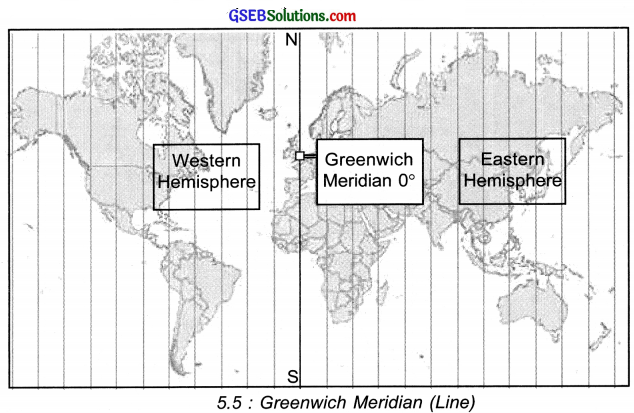
B. International Date Line:
- The International Date Line is an imaginary line on earth from North to the South pole.
- IDL is the International Date Line.
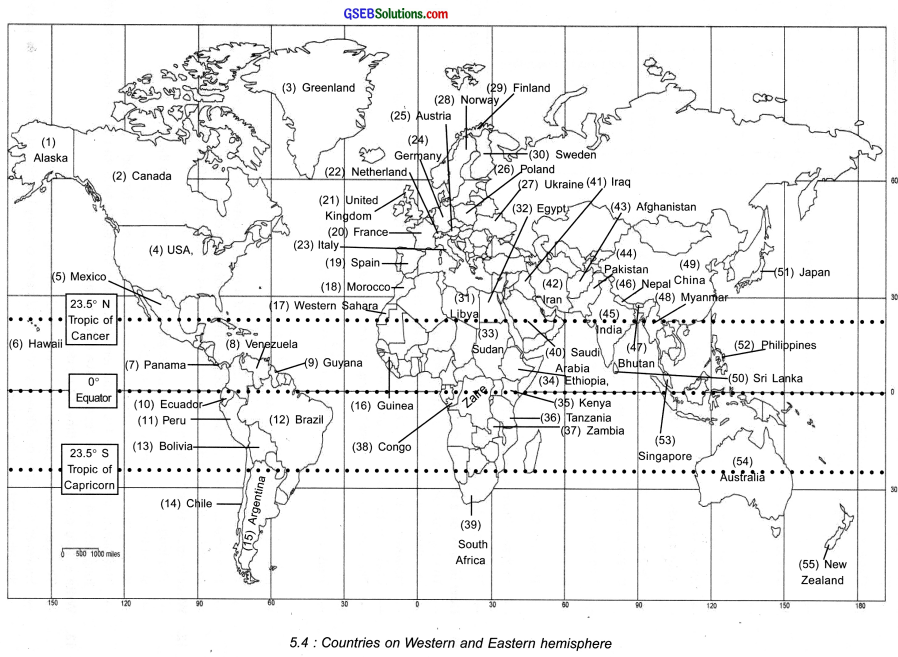
- The 180° longitude is known as International Date Line.
- There is only one longitude at 180°.
- It passes through the Pacific Ocean.
- When a person crosses IDL, the date and day change.
A. Shape of the IDL:
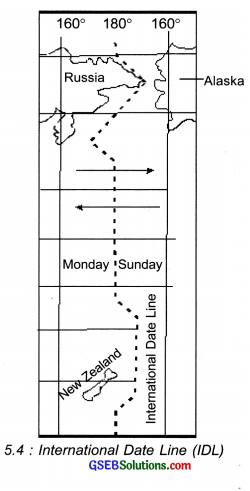
- The IDL is supposed to be straight but it is not.
- At quite a few places, it is zigzag.
- When drawn straight, this longitude passes through many islands of the Pacific Ocean.
- Hence, when the line passed through such islands, the locations there had two days and dates.
- This created a disorder for these islands.
- Hence the IDL was drawn only from the water bodies.
- Thus the IDL does not pass from any land forms.
- To draw it from water bodies, it had to be made zigzag.
- Thus, the shape of the IDL is zigzag.
![]()
Question 14.
The time of one place differs from other. Give reason.
Answer:
- The biggest clock of the earth is the sun.
- The time of a place is decided by the location of the sun in the sky.
- However, to be precise, the time of the places on the earth is decided through longitudes.
- There are total 360 longitudes on the earth.
- The earth takes 24 hours to complete one rotation.
- Thus, in one hour, 15 longitudes (\(\frac{360}{24}\) = 15) pass through the sun.
- In other way, it takes 4 minutes (\(\frac{60}{15}\) = 4) for the earth to pass one longitude through the sun.
- This makes it clear that there is difference of 4 minutes between two adjacent longitudes.
- This time difference is used to decide the time of a particular place.
- According to this, the time at different longitudes is different at different places on the earth.
Question 15.
Why are places denoted by E, W, N or S?
Answer:
- The places or nation on the east of the Greenwich Line (0°) are denoted by E.
- The places on the west of the Greenwich Line are denoted by W.
- The places situated in the north of the Equator (0°) are denoted by N.
- The places situated in the south of the Equator are denoted by S.
Answer in One or Two Sentence
Note : Here, answers are given in short for memorizing easily. Students must write full sentences.
Question 1.
What are latitudes?
Answer:
The horizontal lines drawn on the globe of the earth.
Question 2.
What are longitudes?
Answer:
The vertical lines drawn on the globe of the earth.
Question 3.
What is Northern Hemisphere?
Answer:
The part of the earth above the 0° latitude i.e. the Equator, in the north.
Question 4.
What is Southern Hemisphere?
Answer:
The part of the earth below the 0° latitude i.e. the Equator, in the south.
![]()
Question 5.
What is North Star?
Answer:
A bright shining star in the northern direction used to know latitudes.
Question 6.
What is Greenwich Line?
Answer:
The 0° longitude which divides the earth into two halves, namely Eastern and Western Hemispheres.
Question 7.
Why is the 0° longitude called Greenwich Line?
Answer:
Because it passes through Greenwich of England.
Question 8.
Which continents fall in the Eastern Hemisphere?
Answer:
Asia, Europe, New Zealand and parts of Africa.
Question 9.
Which continents fall in the Western Hemisphere?
Answer:
North America, South America and parts of Africa.
Question 10.
When does the date or day change?
Answer:
When a person crosses the 180° longitude i.e. the International Date Line.
Question 11.
On which longitude is India located?
Answer:
Between 68.7° E to 97.25° E.
![]()
Question 12.
How is the standard time of the country decided?
Answer:
By following the local time of any one place which is situated in the middle of the country.
Question 13.
Define: Standard time.
Answer:
A fix time which is common for the entire nation is called
Question 14.
What decides the standard time of India?
Answer:
The 82.5° E longitude which is located near Allahabad.
Question 15.
Why is standard time necessary?
Answer:
For punctuality in work and convenience at work
Question 16.
Which nations have more than one standard time?
Answer:
Big countries extended towards east-west.
Question 17.
Name a few countries ahead of time in comparison to India.
Answer:
Bangladesh, New Zealand, Singapore, Japan, Australia, China, etc.
![]()
Question 18.
Name a few countries behind of time in comparison to India.
Answer:
Pakistan, U.S.A., Canada, Uganda, France, Ukraine, etc.
Multiple Choice Questions
Question 1.
Latitudes are imaginary ………………… lines.
(A) Horizontal
(B) Vertical
(C) Oblongular
(D) Zigzag
Answer:
(A) Horizontal
Question 2.
The part above the 0° latitude is called ………………… Hemisphere.
(A) Northern
(B) Southern
(C) Eastern
(D) Western
Answer:
(A) Northern
Question 3.
The ………………. Hemisphere is below the Equator.
(A) Northern
(B) Southern
(C) Eastern
(D) Western
Answer:
(B) Southern
Question 4.
We can know the exact latitude and longitude of a place with the help of …………….. .
(A) GPS
(B) GPRS
(C) Magnetic compass
(D) All of these
Answer:
(A) GPS
Question 5.
Greenwich is located in ………………..
(A) Ireland
(B) Scotland
(C) Germany
(D) England
Answer:
(D) England
![]()
Question 6.
………………… divides the earth into east and west.
(A) Equator
(B) Tropic of Capricorn
(C) Greenwich Line
(D) International Date Line
Answer:
(C) Greenwich Line
Question 7.
There are total ………………. longitudes.
(A) 90
(B) 180
(C) 260
(D) 360
Answer:
(D) 360
Question 8.
Which longitude is known as International Date Line?
(A) 90°
(B) 120°
(C) 0°
(D)180°
Answer:
(D)180°
Question 9.
IDL passes through the …………………. Ocean.
(A) Antarctic
(B) Arctic
(C) Pacific
(D) Atlantic
Answer:
(C) Pacific
Question 10.
What is the shape of IDL?
(A) Straight
(B) Zigzag
(C) Criss-cross
(D) Oblique
Answer:
(B) Zigzag
Question 11.
The biggest clock of the earth is the ……………….. .
(A) Sun
(B) Moon
(C) Stars
(D) None of these
Answer:
(A) Sun
![]()
Question 12.
The earth takes ……………….. to complete one rotation.
(A) 24 hours
(B) 365 days
(C) A fortnight
(D) A leap year
Answer:
(A) 24 hours
Question 13.
How many longitudes pass through the sun in one hour?
(A) 12
(B) 15
(C) 4
(D) 8
Answer:
(B) 15
Question 14.
There is a difference of …………………. minutes between two adjacent longitudes.
(A) 4
(B) 8
(C) 15
(D) 20
Answer:
(A) 4
Question 15.
When the sun is exactly on a longitude, it is ………………. in that place.
(A) 12 am
(B) 12 pm
(C) 8 am
(D) 8 pm
Answer:
(B) 12 pm
Question 16.
Standard time of the country is decided by following the local time of the place located in the
………………….. of the country.
(A) Extreme north
(B) Extreme south
(C) Middle
(D) Any of these
Answer:
(C) Middle
Question 17.
The standard time of India is decided from the ……………….. longitude.
(A) 68° W
(B) 82.5° E
(C) 98° W
(D) 102.5° E
Answer:
(B) 82.5° E
![]()
Question 18.
The longitude that decides the standard time of India passes from near ………………… .
(A) Varanasi
(B) Haridwar
(C) Dehradun
(D) Allahabad
Answer:
(D) Allahabad
Question 19.
The places on the east of the ……………. are denoted by E.
(A) Equator
(B) IDL
(C) Arctic Circle
(D) Greenwich Line
Answer:
(D) Greenwich Line
Question 20.
What is the distance between two latitudes?
(A) 121 km
(B) 242 km
(C) 111 km
(D) 282 km
Answer:
(C) 111 km
Question 21.
Which longitude is known as IDL?
(A) 82.5°
(B) 90°
(C) 180°
(D) 360°
Answer:
(C) 180°
Question 22.
The latitudes are drawn from …………….. to……………
(A) East, West
(B) North, South
(C) East, South
(D) North, West
Answer:
(A) East, West
Question 23.
The longitudes are drawn from ………………… to…………….. .
(A) East, West
(B) North, South
(C) West, South
(D) South, East
Answer:
(B) North, South
Question 24.
Which of these countries is not located in the south of the Equator?
(A) Chile
(B) Brazil
(C) Egypt
(D) Both A and B
Answer:
(C) Egypt
![]()
Question 25.
The Equator passes from ………………. .
(A) Indonesia
(B) Uganda
(C) Columbia
(D) All of these
Answer:
(D) All of these
Question 26.
The ……………… passes through India.
(A) Equator
(B) Tropic of Cancer
(C) Tropic of Capricorn
(D) Antarctic circle
Answer:
(B) Tropic of Cancer
Question 27.
Through which nation of South America does the Tropic of Cancer pass?
(A) Mexico
(B) Alaska
(C) Greenland
(D) Eucador
Answer:
(A) Mexico
Question 28.
Through which continent does the Tropic of Capricorn pass?
(A) Asia
(B) North America
(C) Europe
(D) Australia
Answer:
(D) Australia
Question 29.
The Greenwich Line passes through ………………… .
(A) Japan
(B) Canada
(C) Singapore
(D) Spain
Answer:
(D) Spain
Question 30.
New Zealand is in the ……………… Hemisphere.
(A) Western
(B) Eastern
(C) Southern
(D) Both B and C
Answer:
(D) Both B and C
Fill in the blanks
1. There is a luminating star in the north direction which is called ………………. .
Answer:
North star
2. ………………… helps us in knowing the exact latitude and longitude of a place.
Answer:
Satelite
![]()
3. The full form of IDL is …………………. .
Answer:
International Date Line
4. The full form of GPS is …………………. .
Answer:
Global Positioning System
5. The IDL is drawn from ………………….. .
Answer:
Water bodies
6. In olden times, the time of the place was decided with the help of the location of the ……………………. .
Answer:
Sun
7. Today, the time of the places on the earth is decided through ………………. .
Answer:
Longitudes
8. When its 3 p.m. in ………………… city, it is 3 p.m. everywhere in India.
Answer:
Allahabad
9. The countries situated on the north of the Equator are denoted by …………………. .
Answer:
N
![]()
10. 180° longitude is called ………………… .
Answer:
lnternational Date Line
11. When the IDL is crossed, the ………………… change.
Answer:
Date and day
12. When time of a place is decided on the basis of its mid-noon, it is called ……………… time.
Answer:
Local
13. ………………… longitudes will pass through sun in three hours.
Answer:
45
14. India is located between ………………. and ………………. longitudes.
Answer:
68.7°E, 97.25° E
15. Sun rises early in the countries in …………………. Hemisphere.
Answer:
Eastern
True or False
1. The vertical imaginary lines drawn on the globe of the earth are known as latitudes.
Answer:
False
![]()
2. The IDL is used to decide time.
Answer:
False
3. Nepal follows same time as India.
Answer:
True
4. Sri Lanka follows same time as India.
Answer:
True
5. The places located on the same longitude may have different time.
Answer:
False
6. There are 180 longitudes in total.
Answer:
False
7. Huge countries may have more than one standard time.
Answer:
True
8. The IDL is zigzag.
Answer:
True
![]()
9. The local time and standard time are two different concepts.
Answer:
True
10. The IDL passes through Siberia.
Answer:
False